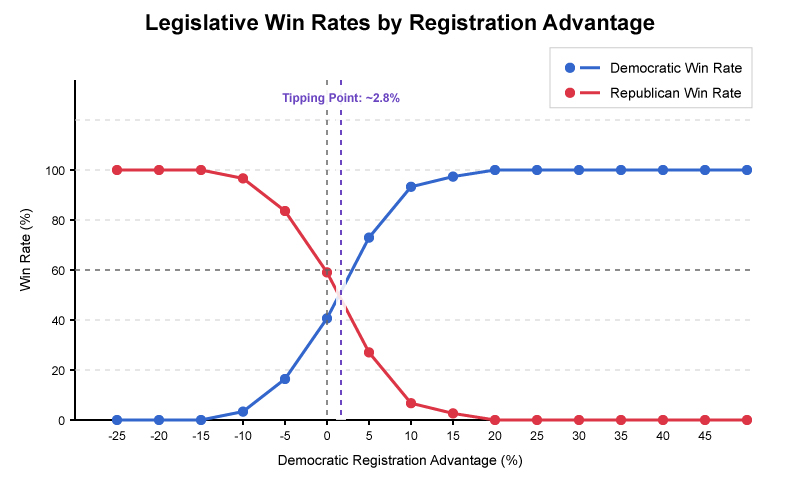When Does a District Become Impossible to Win?
In previous blog posts, we analyzed the 2024 Congressional and Assembly elections to identify candidates who exceeded or fell short of expectations.
Today, we’re approaching the data from a different angle to address an intriguing question: at what point does voter registration make a district effectively unwinnable for a Republican or Democrat?
Political professionals often glance at voter registration numbers to gauge election competitiveness. A district where Democrats hold a 3% registration edge might seem winnable for Republicans. But what about a 6% advantage? Or even 10%? We know the odds diminish, but how sharply?
To find out, we examined voter registration data and election results from every contested Congressional, Assembly, and State Senate race in California since 2014—704 elections in total. We sorted these elections into groups based on the Democrat voter registration advantage, using increments of 5%. Within each group, we calculated how often the Democrat or Republican candidate emerged victorious.
Discover California's Political Landscape
Explore district-level election data, demographic insights, and political trends for every jurisdiction in California.
Here’s what we discovered:
| Dem Reg. Advantage | Total Races | Dem Wins | Dem Win Rate | Rep Win Rate |
|---|---|---|---|---|
| Under -20% | 1 | 0 | 0.0% | 100.0% |
| -20% to -15% | 19 | 0 | 0.0% | 100.0% |
| -15% to -10% | 46 | 0 | 0.0% | 100.0% |
| -10% to -5% | 49 | 2 | 4.1% | 95.9% |
| -5% to 0% | 39 | 8 | 20.5% | 79.5% |
| 0% to 5% | 38 | 16 | 42.1% | 57.9% |
| 5% to 10% | 41 | 27 | 65.9% | 34.1% |
| 10% to 15% | 54 | 46 | 85.2% | 14.8% |
| 15% to 20% | 76 | 71 | 93.4% | 6.6% |
| 20% to 25% | 76 | 76 | 100.0% | 0.0% |
| 25% to 30% | 97 | 97 | 100.0% | 0.0% |
| 30% to 35% | 64 | 64 | 100.0% | 0.0% |
| 35% to 40% | 44 | 44 | 100.0% | 0.0% |
| 40% to 45% | 17 | 17 | 100.0% | 0.0% |
| 45% to 50% | 13 | 13 | 100.0% | 0.0% |
| Over 50% | 30 | 30 | 100.0% | 0.0% |


As you can see, the tipping point—where a district effectively becomes a 50/50 toss-up—is around a 3% voter registration advantage for Democrats. That means even a seemingly balanced district slightly favors Democratic candidates based on registration alone.
However, districts don’t all behave uniformly, which is why our past analyses have often compared district outcomes against statewide trends. To better illustrate these differences, we’ve identified elections since 2014 where candidates most dramatically defied their district’s voter registration numbers—not by margin of victory, but by overcoming significant registration disadvantages.
For Republicans, most of these surprising wins occurred in the Central Valley, an area with heavily Hispanic populations registered predominantly as Democrats but whose voters historically turn out at lower rates compared to Democratic voters elsewhere in California. This turnout gap has enabled Republicans to achieve notable victories far exceeding what registration figures alone would predict.
For Democrats, the greatest upsets occurred predominantly in Southern California during the 2018 midterms, reflecting a substantial but initially hidden voter shift away from Republicans that voter registration data had not yet captured.
With over 700 races studied, we’ve created a robust indicator of the point at which voter registration advantages become decisive in partisan elections. While these findings are most applicable to explicitly partisan races, they also provide valuable insight into local elections that, although officially nonpartisan, often take on partisan characteristics due to party involvement or other dynamics.
TOP 10 REPUBLICAN WINNERS IN DEMOCRATIC-LEANING DISTRICTS
Andy Vidak (REP)
- Registration: 62.1% D / 37.3% R
- Win Margin:54.1%
David Valadao (REP)
- Registration: 61.2% D / 38.3% R
- Win Margin:56.7%
David G. Valadao (REP)
- Registration: 62.0% D / 37.2% R
- Win Margin:51.5%
David Valadao (REP)
- Registration: 60.3% D / 39.2% R
- Win Margin:57.8%
David G. Valadao (REP)
- Registration: 60.9% D / 38.4% R
- Win Margin:50.4%
Leticia Castillo (REP)
- Registration: 59.4% D / 38.7% R
- Win Margin:50.2%
John Duarte (REP)
- Registration: 59.5% D / 39.5% R
- Win Margin:50.2%
Jeff Gonzalez (REP)
- Registration: 59.0% D / 40.0% R
- Win Margin:51.8%
David G. Valadao (REP)
- Registration: 59.2% D / 40.1% R
- Win Margin:53.4%
Anthony Cannella (REP)
- Registration: 58.2% D / 41.1% R
- Win Margin:60.5%
TOP 10 DEMOCRATIC WINNERS IN REPUBLICAN-LEANING DISTRICTS
Harley Rouda (DEM)
- Registration: 43.5% D / 56.1% R
- Win Margin:53.6%
Katie Porter (DEM)
- Registration: 45.5% D / 54.2% R
- Win Margin:52.1%
Cottie Petrie-Norris (DEM)
- Registration: 46.4% D / 53.3% R
- Win Margin:52.7%
Mike Levin (DEM)
- Registration: 47.0% D / 52.7% R
- Win Margin:56.4%
Scott Peters (DEM)
- Registration: 48.8% D / 50.7% R
- Win Margin:51.6%
Raul Ruiz (DEM)
- Registration: 48.9% D / 50.1% R
- Win Margin:54.2%
Katie Porter (DEM)
- Registration: 49.5% D / 50.2% R
- Win Margin:53.5%
Cottie Petrie-Norris (DEM)
- Registration: 49.6% D / 50.0% R
- Win Margin:50.5%
Dave Min (DEM)
- Registration: 49.7% D / 49.9% R
- Win Margin:51.1%
Dave Min (DEM)
- Registration: 49.8% D / 49.8% R
- Win Margin:51.4%
Find this analysis helpful?
Get more California political insights and data-driven analysis delivered to your inbox.